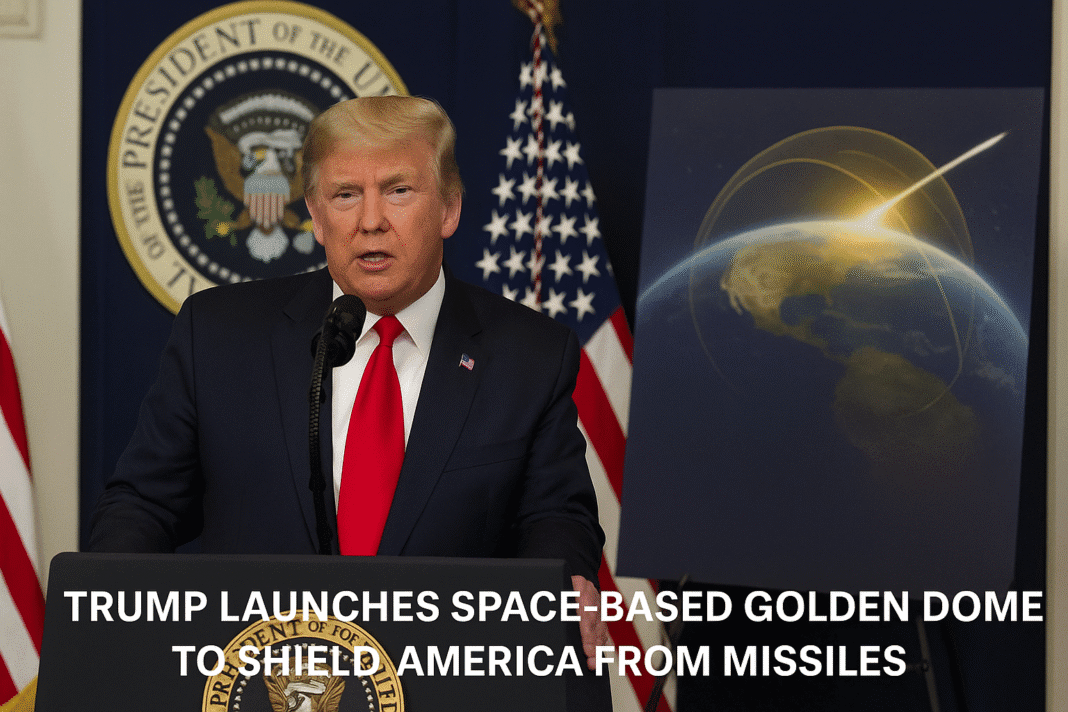In a dramatic announcement made from the Oval Office, former President Donald Trump revealed a groundbreaking and highly ambitious military initiative that is set to redefine the landscape of national security for the United States.
This new initiative, called the Golden Dome, is an expansive missile defense system designed to guard the entire country from the growing threats of hypersonic weapons, ballistic missiles, cruise missiles, and potentially even space-based weapons. By merging land, sea, and space-based sensors, this multi-domain shield could usher in a new era of strategic deterrence and international posturing.
The Golden Dome Missile Defense Program: A Strategic Leap
Unlike existing systems such as Israel’s renowned Iron Dome, which primarily intercepts short-range rocket attacks, the Golden Dome missile defense system aims to confront far more complex and long-range threats. It is conceptualized as a layered defense infrastructure capable of detecting and neutralizing high-speed and evasive missile attacks, some of which may originate from deep-sea submarines, high-altitude bombers, or even orbital platforms.
The decision to build this futuristic defense apparatus came through a formal executive order, signed in a high-profile ceremony in the White House. Flanked by military officials and defense advisors, President Donald Trump emphasized that the Golden Dome program would not only ensure unmatched security for American citizens but also serve as a formidable deterrent in an age where hypersonic weapons and other next-generation technologies are becoming increasingly common among U.S. adversaries.
Funding the Future: A $175 Billion Gamble
At the heart of discussions around the Golden Dome lies its staggering cost. Initial funding of $25 billion has already been allocated to kickstart the early research, development, and deployment phases. However, the Congressional Budget Office estimated that the Golden Dome could cost as much as $175 billion by the time it becomes fully operational—a sum that makes it one of the most expensive defense programs in U.S. history.
From Space to Trade Deals: Trump’s Missile Shield Pitch to Japan May Change Everything
Even more concerning is the long-term financial outlook. Over the course of 20 years, some analysts project that the total expenditures could balloon to anywhere between $161 billion and $542 billion, especially when factoring in maintenance, upgrades, and regional expansions. The Center for Strategic and International Studies, a leading defense think tank, has echoed these concerns, noting that while the investment may boost national security, it also risks becoming a financial black hole if not carefully managed.
Space: The Final Frontier for Defense
One of the defining features of the Golden Dome missile defense system is its revolutionary use of space-based sensors and interceptors. These tools will provide real-time global surveillance, monitoring potential missile launches from hostile nations or rogue actors. By deploying sensor networks in orbit, the Space Force will play a critical role in overseeing operations and ensuring coordination across the system’s multi-tiered architecture.
The move to integrate space-based weapons has drawn both intrigue and concern. The Golden Dome is not just a terrestrial shield; it’s a celestial guardian capable of striking threats beyond Earth’s atmosphere. The system’s offensive capabilities in space have sparked unease internationally, particularly from nations like Russia and China, who argue that such developments may lead to the militarization of outer space and trigger a new arms race.
Nevertheless, proponents argue that these innovations are necessary in the face of advancing missile technologies, particularly those involving hypersonic weapons, which travel at speeds exceeding Mach 5 and can maneuver mid-flight, making them nearly impossible to intercept using older technologies.
Stop Weaponizing the Stars! China Warns U.S. Against Triggering Space Arms Race
Global Reactions and Cooperative Defense
The unveiling of the Golden Dome has sent ripples across the global diplomatic community. Countries like Russia, China, and North Korea have openly condemned the project, warning that the deployment of space-based weapons could dangerously destabilize existing security arrangements. These nations argue that the United States is pushing the boundaries of international law and that the Golden Dome program may provoke other nations to build similar capabilities, thereby increasing the risk of space-related conflicts.
On the flip side, U.S. allies in North America and Europe have expressed interest in potential collaborations. Discussions are already underway between defense officials of Canada and the United Kingdom for possible integration with the Golden Dome framework, hinting at a future where missile defense becomes a shared responsibility across the Western alliance.
To ensure smooth execution, the Department of Defense has appointed Secretary Pete Hegseth as the principal coordinator for the Golden Dome program. Known for his strong military background and experience in policy oversight, Hegseth has been tasked with overseeing inter-agency cooperation between the Pentagon, the Space Force, and American intelligence services. His mandate includes ensuring that all systems—from space-based sensors to naval and ground interceptors—are integrated into a seamless command structure capable of instant response.
Hegseth also serves as the face of the program’s public communication strategy. At a recent Center for Strategic and International Studies forum, he stated, “The Golden Dome missile defense system is not merely a tool; it is a statement. It tells the world that the United States will not sit idly while threats evolve—we will lead from the front.”
From Threat Detection to Neutralization
At its core, the Golden Dome relies on a network of ultra-sensitive space-based sensors that continuously scan the globe. These sensors can detect heat signatures, electromagnetic anomalies, and trajectory patterns associated with missile launches. Upon detecting a threat, data is relayed within seconds to command centers, which then activate interceptors from land, sea, or space platforms.
Trump Floats Shock Deal: Golden Dome For $61B — Or Canada becomes 51st State! 🇨🇦🔥
Naval destroyers equipped with cutting-edge radar systems will patrol international waters, providing mobile launch points for interceptors. On land, missile silos and mobile launcher systems will remain on high alert. But the most notable innovation is the orbital interceptors—designed to deploy in minutes and eliminate threats before they even enter Earth’s atmosphere.
This missile defense system will be built on real-time communication. Through secure quantum encryption networks, all operational units—spacecraft, ships, ground stations—will share intelligence instantaneously, allowing the Golden Dome to deliver a cohesive and lightning-fast defense.
Symbolism in the Name: A Golden Dome Over America
The name Golden Dome was deliberately chosen to reflect strength and protection. While inspired by Israel’s Iron Dome, which is widely credited for saving lives by intercepting short-range rocket attacks, the Golden Dome aspires to a much broader mission. It’s not about countering regional threats—it’s about securing the entire continental U.S. and its territories against the evolving nature of modern warfare, including from outer space.
The “golden” in the name is not just symbolic of value and resilience, but also of ambition. Where the Iron Dome deals with immediate dangers, the Golden Dome is looking decades ahead, ready to face threats that are only just being imagined.
Golden Dome bid turns intense with SpaceX’s controversial entry
With an initial price tag of $175 billion and an operational timeline extending across 20 years, the Golden Dome is set to become a defining element of U.S. defense strategy. As the Congressional Budget Office estimated, the ultimate costs could dwarf any existing defense initiative, but for its supporters, that cost is justified in a world where adversaries are rapidly innovating.
The Golden Dome program doesn’t just represent technological advancement; it signifies the transformation of how nations view defense—not just as something grounded on Earth, but extending into the cosmos. Whether it succeeds in preventing conflict or accelerates global tensions remains to be seen, but one thing is certain: the Golden Dome missile defense system is a powerful symbol of the United States’ evolving defense doctrine in the 21st century.




